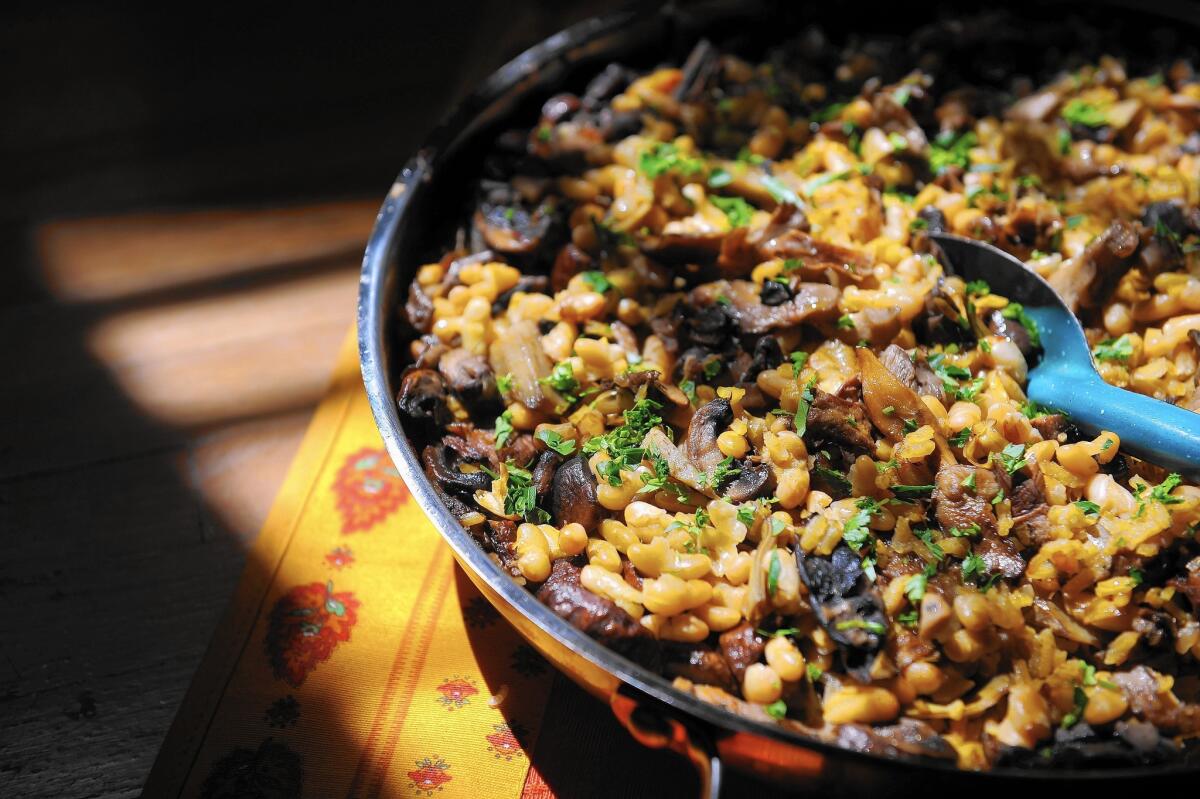No chicken or chorizo in sight -- vegetables star in these aromatic and healthful paellas

- Share via
Tell your friends you’re making paella and they’ll envision seafood and/or meat on saffron-colored rice in a huge paella pan. But tell chef María José San Román, a native of Alicante, in the rice-growing region of Valencia in southeastern Spain, and a different sort of rice dish comes to mind.
“Where I come from, the paella that we make in homes is most often a rice dish made with whatever produce is in season,” says the co-owner and executive chef of the Alicante-based restaurant group Grupo Gourmet that includes the renowned Michelin-starred restaurant Monastrell.
San Román was speaking in January to a group of nutritionists and corporate and executive chefs of volume food-service operations at the Worlds of Healthy Flavors leadership retreat in St. Helena, Calif., a conference organized by the Culinary Institute of America and the Harvard T.H. Chan School of Public Health to help chefs with more healthful food choices for their customers. To illustrate her point, she cooked an aromatic paella made with artichokes and mushrooms, garlic, olive oil, saffron, mushroom broth and rice. Not a sausage or a piece of chicken, a shrimp or a mussel to be found. The chefs were impressed.
There’s no reason why a vegetable version of this signature Valencian rice dish, which is named for the wide, flat pan in which it is traditionally cooked, should not impress. Vegetable paellas aren’t the big production numbers that seafood and/or meat paellas tend to be, but the aromatic rice makes a great backdrop for produce. I let the farmers market inspire me and try to keep the number of different vegetables in each paella to a minimum, usually about three.
The dish is really all about rice, olive oil, usually saffron (but not always) and broth. Traditionally, a short- or medium-grain rice is used for paella. It is sautéed in abundant olive oil before the addition of broth, which usually includes a generous pinch of saffron. The rice cooks — undisturbed — until it is dry and sticking to the bottom of the pan, where it forms a crispy golden layer that should be scraped up with every serving. It should be chewy and slightly sticky. You can find imported Spanish rice for paella in specialty stores such as Surfas and gourmet groceries, but Arborio and domestic medium- and short-grain rice work well too.
These recipes call for saffron, which if it is true Spanish saffron, is an expensive ingredient. You can get away without it in the mushroom and artichoke paella, as the yellow hue does not show through the strong mushroom broth, although the flavor emerges. But you’ll want that beautiful color and flavor in the paella with turnips and peas. You will get the most out of saffron if you infuse it in a little warm water before adding it to the rice.

Recipe: Paella with turnips, peas and spring onions
Great big paellas made on a grill are fun, but if you’re going to make one on the stove, you’ll want to use a smaller pan no larger than 12 or 13 inches. When you try to use the bigger pans on burners, no matter how often you rotate it and change its position, you end up with some rice that is underdone and some that is scorched. Paella pans come in many sizes; I used a 13-inch for one of these recipes and a 12-inch for another. You can also use a 12-inch skillet.
One of these recipes was inspired by an artichoke and mushroom paella that San Román made. Young artichokes are hitting the market now and are perfect for this, though larger artichokes trimmed down to the heart will work fine too. I made a strong mushroom broth using dried porcinis, and I used a mix of meaty oyster mushrooms and creminis in the paella.
Recipe: Paella with artichokes and mushrooms
The turnip paella with peas is inspired by a classic baked rice dish from Valencia made with turnips and duck (arròz amb anèc i naps). Sweet peas and baby turnips show up at the same time of year in Los Angeles farmers markets. They complement each other beautifully. But baby turnips are not essential; regular diced turnips work too. Paella is a forgiving dish.
These paellas are made in two steps. First, the vegetables are prepared and cooked in the paella pan or skillet and removed; then the rice is cooked in olive oil before the vegetables are stirred back in and the broth is added. The first step can be done up to a few hours before you proceed with the rice. This makes it a great dish for a dinner party, because the dish can be half finished before your guests arrive, and your kitchen will already smell terrific.
Martha Rose Shulman is a cookbook author and food writer based in Los Angeles.
More to Read
Eat your way across L.A.
Get our weekly Tasting Notes newsletter for reviews, news and more.
You may occasionally receive promotional content from the Los Angeles Times.










